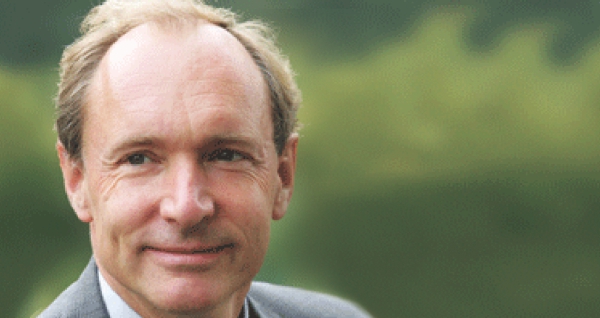| Post Campus
Tim Berners-Lee:
Father of the World
Wide Web
Asrar Chowdhury
Imagine there's no World Wide Web (WWW). It's not possible even if you try. Add to the list, no HTML; no HTTP; and no URL. Could you ever give that a try? Here is a question that may open your eye. Do you know the man who created the WWW? And do you know what he did with his invention, by taking the Robert Frost road 'less travelled by'? Indeed, that is what 'made all the difference'. This is the story of Tim Berners-Lee, Father of the World Wide Web, the man who gifted the WWW to Mankind on Christmas Day, 1992- two decades ago.
Tim Berners-Lee was born on June 8, 1955 in Southwest London. His parents, Conway Berners-Lee and Mary Lee Woods worked on the first commercially built computer, the Ferranti Mark 1 that was developed at the University of Manchester in 1951. From childhood, Berners-Lee had a habit of forgetting names and faces. While reading or studying, he would note down on a piece of paper names and topics he needed to get back to, if needed. It was this habit of marking notes while reading that lead to the creation of what is now taken for granted- the Hypertext. After earning a first-class in Physics from Queen's College, Oxford, two stints at CERN lead to the creation of the World Wide Web.

Berners-Lee considers 'random reasons' behind being at CERN, the 'right place at the right time' that lead to the creation of the Web. CERN- the European physics laboratory in the borders between Switzerland and France was 'the' Internet node in the 1980s. In 1980, Berners-Lee created the programme Enquire. The programme could fill a document with keywords. This would lead the reader to other documents for further elaboration. Berners-Lee called this a 'personal memory substitute'. Although Enquire was a forerunner of today's Hypertext, the concept was not new. The concept was first outlined by Vannevar Bush in 1945. Bush argued that this line of reasoning is similar to that of the human brain. The Hypertexts of the 1980s lacked today's 'dangling links'. There were no arrows pointing to anything; no mouse clicks leading to anywhere.
In 1989, Berners-Lee was back at CERN for a second stint. He wrote a proposal to link CERN's resources via Hypertext. Hypermedia- his initial attempt was not received with warmth. Finally, after persuading CERN to purchase a NeXT computer, and collaborating with others, Berners-Lee developed the three technical pillars of the Web. The language for encoding documents (HTML: Hypertext Markup Language); the system for linking documents (HTTP: Hypertext Transfer Protocol); and the system for addressing (naming) documents (URL: Universal Resource Locator). Berners-Lee also wrote the first server software, although marketing gurus of the time created the myth that Andreessen of Netscape achieved this feat.
The idea of a global Hypertext system originates from the 1960s. Ted Nelson first pursued the idea in the Xanadu project. However, Nelson wanted Xanadu to be a profit-making concern. This complicated matters at the time. Xanadu became a Dodo bird, failed to fly and became extinct. Berners-Lee persuaded CERN to forsake intellectual property rights (IPR). A Web in the public domain, free for anybody to use, send to friends and even leaving the scope of improving on it was not unknown to the scientific community, but almost never tried at a popular level before. Needless to say, Berners-Lee's proposal did not create a Dodo bird. It created a Swift bird!
The next step was to come up with a name. This always seems to be the hardest part of all in any creation- computer, literary or even naming a child. Infomesh, Infomess, TIM his own name in an acronym all failed the test. Finally he came up with World Wide Web or WWW in its acronym as we know it today. This was the penultimate decision. The ultimate decision came in whether or not to give into temptation- to mint money by accepting royalties from IPR. On Christmas Day in 1992- exactly two decades ago, Tim Berners-Lee set his creation, WWW free to the world as a gift to Mankind. The rest is history even if many are not aware of the history and the immense magnanimity of the man in gifting away such a potentially lucrative invention for the betterment of Mankind.
Like Jonas Salk of the USA who did not patent the world's first polio vaccine to make it available to save the lives of children, Tim Berners-Lee decided not to benefit from patenting the World Wide Web. To this day, Tim Berners-Lee remains one of the unsung heroes of the information age. He remains the sugar in our milk- invisible- as we take the sweetness of the milk for granted. His dream was to do something for Mankind by gifting the three most powerful W's man will ever know as a gift on Christmas Day in 1992. Since then and till now, Berners-Lee has never regretted his decision. In his own words "The Web is not a network of computers. The Web is a network of people". Indeed, Sir. Your gift has made all the difference to Robert Frost's poem. Thanks for the World Wide Web!
(The author teaches economic theory at Jahangirnagar University and North South University.)
|
|
|
